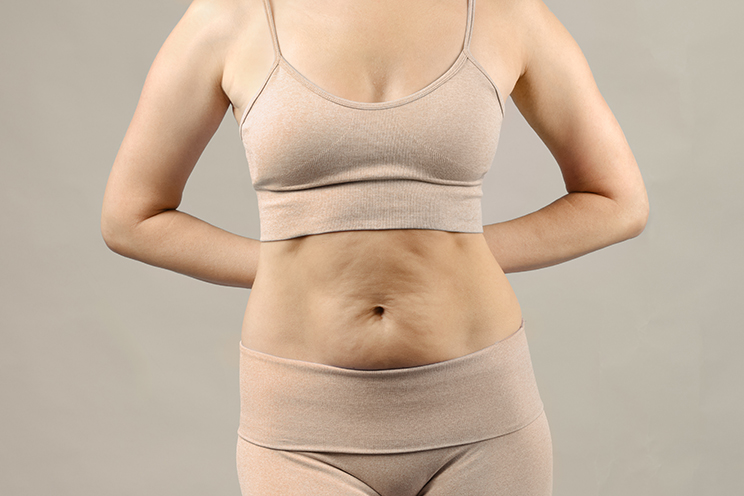Ihon löystyminen

Ihon löystyminen on ongelma, joka voi vaikuttaa moniin kehon alueisiin ja sen esiintyminen on yleistä erityisesti painonmuutosten, ikääntymisen tai raskauden jälkeen. Vaikka löystyminen voi olla luonnollinen osa kehon muutoksia, monet kokevat sen esteettiseksi huolenaiheeksi. Erityisesti käsivarsissa, vatsassa, selässä, pakaroissa ja reisissä voi esiintyä veltostumista, mikä johtuu ihon menettämästä kimmoisuudesta ja elastisuudesta. Kimmoisuus on ihoa tukevien proteiinien, kuten kollageenin ja elastiinin, ansioita. Näiden proteiinien väheneminen voi heikentää ihon venymistä ja palautumista.
Ihon löystyminen ei ole pelkästään esteettinen huolenaihe, vaan se voi myös vaikuttaa kehon toimintoihin, kuten liikkumiseen tai vaatteiden valintaan. Esimerkiksi käsivarsissa ja vatsassa löystyminen voi tehdä kehon linjoista vähemmän määriteltyjä. Tämä voi vaikuttaa itsetuntoon ja kehonkuvaan, vaikka kyseessä olisi täysin luonnollinen prosessi, kuten seuraus ikääntymisestä tai raskaudesta. Lähes jokainen kokee jossain vaiheessa elämäänsä jonkinlaista ihon löystymistä, mutta sen aste ja vaikutus voivat vaihdella yksilöllisesti.
Mistä ihon löystyminen johtuu?
Ihon löystymiselle on monia syitä, jotka liittyvät kehon sisäisiin ja ulkoisiin tekijöihin. Yksi keskeisimmistä syistä on ikääntyminen. Ikääntyessä elimistön tuottama elastiini ja kollageeni vähenevät luonnollisesti, mikä heikentää ihon kimmoisuutta. Tämä prosessi on täysin normaali osa vanhenemista, mutta se voi näkyä erityisesti alueilla, joissa iho on joutunut venymään tai rasitetuksi.
Painon vaihtelut ovat toinen merkittävä tekijä, joka voi vaikuttaa ihon kiinteyteen. Kun paino nousee nopeasti ja laskee yhtä nopeasti, iho ei välttämättä ehdi palautua alkuperäiseen muotoonsa. Tämä johtaa usein löysään ja veltostuneeseen ihoon, erityisesti vatsassa, käsivarsissa ja reisissä. Samalla myös rasvakudoksen määrä voi vähentyä, jolloin iho ei enää ole yhtä täyteläinen.
Raskaus on myös yksi yleisimmistä syistä, miksi naiset kokevat ihon löystymistä. Raskauden aikana vatsan alueen iho venyy nopeasti ja laajenee, mutta synnytyksen jälkeen se ei välttämättä palaudu täysin alkuperäiseen muotoonsa. Tämä voi johtaa löysään ihoon erityisesti vatsassa ja pakaroissa.
Hormonaaliset muutokset, kuten vaihdevuodet, voivat myös vaikuttaa ihon kiinteyteen. Estrogeenin määrän lasku voi heikentää ihon elastisuutta ja edistää sen löystymistä. Tällöin iho voi vaikuttaa kuivalta ja vähemmän elastiselta, mikä näkyy erityisesti herkillä alueilla kuten käsivarsissa ja reisien sisäpuolella.

Ihon löystymisen eri muodot ja tyypit
Ihon löystyminen voi ilmetä eri tavoin eri kehon alueilla. Yksi tavallisimmista ongelmista on käsivarsien alueen löystyminen. Käsivarsissa iho on ohuempaa ja herkemmin altis elastiinin ja kollageenin heikentymiselle. Tämä voi johtaa roikkuvaan ihoon, joka on selkeiten havaittavissa käsivarsien yläosassa.
Vatsan alueella iho saattaa löystyä erityisesti raskauksien jälkeen tai painon vaihteluiden seurauksena. Vatsan iho voi jäädä löysäksi ja roikkuvaksi, mikä voi olla esteettinen huolenaihe monille. Samalla myös selkä, pakarat ja reidet voivat kokea samanlaista veltostumista. Reisissä iho on erityisen altis venymiselle ja löystymiselle, erityisesti jos kehon rasvapitoisuus on ollut korkea ja sitten laskenut nopeasti.
Ihon löystyminen voi tapahtua myös kehossa eri vaiheissa. Aluksi iho saattaa tuntua vain hieman vähemmän kimmoisalta ja vähemmän napakalta, mutta ajan myötä se voi muuttua näkyvästi roikkuvaksi ja veltostuneeksi. Tämä prosessi on usein hitaampaa ikääntymisen myötä, mutta voi kiihtyä, jos kehon hormonaaliset muutokset tai painonmuutokset vaikuttavat ihon rakenteeseen.

Hoitomuodot ihon löystymiseen
Ihon löystyminen voi olla esteettinen huolenaihe, mutta onneksi markkinoilla on useita moderneja ja tehokkaita hoitomuotoja, jotka voivat auttaa palauttamaan ihon kiinteyden ja elastisuuden. Tässä on muutamia hoitovaihtoehtoja, jotka voivat olla hyödyllisiä löystyneen ihon kiinteyttämisessä:
- EXION Fractional: Tässä hoidossa yhdistyvät monopolaarinen radiofrekvenssi ja mikroneulaus, joka syöttää energiaa syvälle ihoon tarkasti. Tämä hoito voi parantaa ihon kiinteyttä ja tasoittaa sen pintaa. Säännöllisesti toteutettuna se voi myös palauttaa ihon joustavuuden ja vähentää löysyyttä.
- Profhilo Body: Profhilo Body kiinteyttää löystynyttä ihoa aktivoimalla kollageenin ja elastiinin tuotantoa erittäin puhtaan, pitkä- ja lyhytketjuisen hyaluronihapon avulla, mikä parantaa ihon kosteustasapainoa, elastisuutta ja rakennetta vartalon haastavilla alueilla.
- EMTONE: Kiinteyttää vartalon löystynyttä ihoa stimuloimalla kollageenin ja elastiinin tuotantoa radiofrekvenssi- ja paineaaltoenergian avulla.
- EMSCULPT™ NEO: Hoidon aikana HIFEM-sähkömagneettiset impulssit aiheuttavat voimakkaita lihassupistuksia, jotka stimuloivat uusien lihassäikeiden kasvua sekä vahvistavat ja kehittävät jo olemassa olevia lihaksia. Samanaikaisesti radiofrekvenssilämmitys (RF) parantaa mikroverenkiertoa ja lisää kollageenin tuotantoa, minkä ansiosta iho muuttuu kiinteämmäksi, napakammaksi ja selluliitin näkyvyys vähenee.
- EXION Body: Tässä laitehoidossa yhdistyvät tekoälyohjattu monopolarinen radiofrekvenssi ja Deep Tissue Penetration -teknologia, jotka stimuloivat kollageenin, elastiinin ja hyaluronihapon tuotantoa syvissä kudoksissa sekä kiinteyttävät ihoa.
- EMSCULPT NEO + EXION Body: Tämä tehokas yhdistelmähoito parantaa tuloksia yhdistämällä lihasten vahvistamisen, rasvan vähentämisen ja ihon kiinteyttämisen. EMSCULPT™ NEO rakentaa lihaksia ja polttaa rasvaa, kun taas EXION™ Body tasoittaa selluliittia ja stimuloi ihon nuorekkuudesta vastaavia proteiineja, kuten kollageenia ja elastiinia.
- Ihon kiinteytysvoiteet: Ihon kiinteytysvoiteet sisältävät ainesosia, kuten retinolia ja kollageenia, jotka voivat parantaa ihon elastisuutta ja kiinteyttä. Voiteet voivat tuoda hetkellistä parannusta ihon ulkonäköön.
- Kirurginen ihon kiristys: Jos iho on erittäin löystynyt, kirurginen toimenpide, kuten vatsanahkaleikkaus tai käsivarsien kiristys, voi olla tarpeen. Tämä on invasiivinen hoito, jossa poistetaan liiallista ihoa.
MESQ®
DoctusPlus Oy:n aputoiminimi
Yritys
DoctusPlus Oy
Y-tunnus
3154088-6
Käyntiosoite
Itämerenkatu 11-13 F, 00180 Helsinki
Puhelin
Sähköposti
Aukioloajat
Ma – Pe 11:00 – 19:00